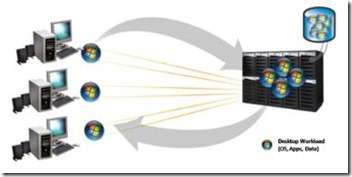Want to Reduce Desktop Costs? (Part 2 or 3) Supplemental
In the main part two of this post I covered Desktop virtualization. As you’ve read it, and I trust found it useful, you may ask about Virtual Desktop Infrastructure (VDI). What wasn’t it included?
It wasn’t in the main post mainly because of it’s potential for cost savings. Microsoft’s documentation about VDI is very much pitched more these days as “Flexible business” rather than cost savings. So why?
 Well, VDI is an alternative desktop delivery model that allows users to access desktops running in the data Center.
Well, VDI is an alternative desktop delivery model that allows users to access desktops running in the data Center.
Unlike RDS / Terminal Services, in VDI each user gets access to a personal desktop from any authorized device, thereby improving desktop flexibility.
However, there is a “but”, strictly speaking VDI does not reduce desktop costs because it can represent a significant up-front investment in infrastructure, including hardware, software, storage, and network. The key statement about is “each user gets access to a personal desktop” this is effectively a VHD you sort centrally. Which means you are storing all the hard drives of all your clients in one place. Storage wise this is not a small investment.
Do read and understand the details covered on the VDI site. The solution does provide flexibly, but before going down this path talk with your Microsoft technical account managers or your Microsoft Partner. You may find that RDS and APP-V combined provide a better solution or App-V along provides a better solution.
So the bottom line is, VDI is a desktop virtualization solution, but not the first one you would be offered by Microsoft.